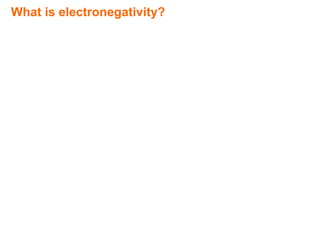
IB 3.2.1.6
- 2. What is electronegativity? In a covalent bond between two different elements, the electron density is not shared equally.
- 3. What is electronegativity? In a covalent bond between two different elements, the electron density is not shared equally. This is because different elements have differing abilities to attract the bonding electron pair. This ability is called an element’s electronegativity.
- 4. What is electronegativity? In a covalent bond between two different elements, the electron density is not shared equally. This is because different elements have differing abilities to attract the bonding electron pair. This ability is called an element’s electronegativity. Electronegativity values for some common elements. Values given here are measured on the Pauling scale.
- 5. Electronegativity and atomic radius The electronegativity of an element depends on a combination of two factors:
- 6. Electronegativity and atomic radius The electronegativity of an element depends on a combination of two factors: 1. Atomic radius As radius of an atom increases, the bonding pair of electrons become further from the nucleus. They are therefore less attracted to the positive charge of the nucleus, resulting in a lower electronegativity.
- 7. Electronegativity and atomic radius The electronegativity of an element depends on a combination of two factors: 1. Atomic radius As radius of an atom increases, the bonding pair of electrons become further from the nucleus. They are therefore less attracted to the positive charge of the nucleus, resulting in a lower electronegativity. higher electronegativity lower electronegativity
- 8. Electronegativity, protons and shielding 2. The number of unshielded protons The greater the number of protons in a nucleus, the greater the attraction to the electrons in the covalent bond, resulting in higher electronegativity.
- 9. Electronegativity, protons and shielding 2. The number of unshielded protons The greater the number of protons in a nucleus, the greater the attraction to the electrons in the covalent bond, resulting in higher electronegativity. However, full energy levels of electrons shield the electrons in the bond from the increased attraction of the greater nuclear charge, thus reducing electronegativity.
- 10. Electronegativity, protons and shielding 2. The number of unshielded protons The greater the number of protons in a nucleus, the greater the attraction to the electrons in the covalent bond, resulting in higher electronegativity. However, full energy levels of electrons shield the electrons in the bond from the increased attraction of the greater nuclear charge, thus reducing electronegativity.
- 11. Electronegativity, protons and shielding 2. The number of unshielded protons The greater the number of protons in a nucleus, the greater the attraction to the electrons in the covalent bond, resulting in higher electronegativity. However, full energy levels of electrons shield the electrons in the bond from the increased attraction of the greater nuclear charge, thus reducing electronegativity. greater nuclear charge increases electronegativity… …but extra shell of electrons increases shielding.